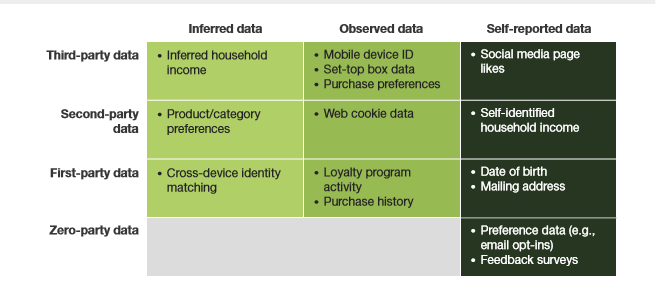As a martech enthusiast, when I look at the bunch of personalization tools out in the market – it sometimes makes me wonder in excitement. The excitement isn’t because of the number of tools (currently the list of martech vendors is close to 12,000), but more so because both privacy regulations and personalization tools are on the rise.
Every B2B marketer knows that the more you personalize, the better your conversion rate. And this trickles down to almost every aspect of marketing from content to customer engagement to advocacy and more. For instance, according to Aberdeen’s research reports, B2B organizations saw a 73% increase in conversion when they engaged their users with relevant content.
So, typically marketers have to be relatable and hyper-personal to their customers and prospects, but this is where the challenge lies. How much should you personalize? When does personalization become creepy? As a marketer, you might not necessarily be breaking the law in your pursuit of personalization excellence, but sometimes the ethics can become questionable.
More and more companies are investing in marketing resources that are pros in privacy regulations such as GDPR, CCPA and more. Most recently in India as of December 2019, The Personal Data Protection Bill (PDPB) has been introduced and is being analyzed currently.
That said, today we are in the age of privacy paradox. I mean there is a lot of inconsistency in terms of what people feel about privacy and their actual behavior. For instance, as customers, we choose convenience over privacy in actual situations.
The classic Buridan’s donkey
Let’s not get caught up between personalization and privacy. In the 14th century, there was a French philosopher and scientist named Jean Buridan. He conducted an experiment where he left a donkey that was equally hungry and thirsty, precisely midway between a stack of hay and a pail of water. It was left for the donkey to decide whether to go towards water or the haystack. But, because of the indecision, the donkey didn’t go either way and died of both hunger and thirst.


And it’s a similar story for us as B2B marketers when it comes to personalization or privacy. We sometimes miss that it is not one vs the other, but a meaningful combination of the two.
The question is – what’s your source of data?
Let’s take the case of Netflix. There is no doubt that they are brilliant in content creation, given the breadth of shows they have. But where they stand out is the kind of personalization they bring in, at scale. Netflix analyzes users based on factors such as the number of users who watched a particular episode of a series, the ones who watch the entire series, the kind of shows watched, the characters and actors preferred and so on. Based on this information, they suggest relevant shows, improve engagement and so on.
But it doesn’t stop there. The trailers and posters you see on your Netflix suggestions won’t be the same as you for your friend, even if it is for the same movie or series. For instance, if you are a Kevin Spacey fan, the trailer you see for House of Cards would feature him exclusively.
How do they do it? When it comes to personalization, the analysis and marketing execution is the relatively easier part (the focus word is ‘relatively’). So, the larger problem at hand is the data you need for personalization. Netflix is blessed that way because their source of data is internal. They are probably one of the best examples for the user-driven economy, which means the success of the platform is largely driven by the number of people on the platform (very much like Uber). Therefore, when you have your data source – slicing and dicing, and putting it to good use is a natural next step.
But most B2B companies don’t have the luxury of sizeable data within their ecosystem. Regardless of whether you do traditional outbound marketing, inbound marketing or account-based marketing (ABM), you have to acquire some amount of data from an external source.
Types of data you can acquire
As a marketer you can acquire three types of data:
- First-party data
- Third-party data
- Zero party data
Most companies spend millions of dollars a year on managing their first-party data and acquiring third-party data. But there’s a good chance that marketers in your company might be missing the opportunity to collect the most valuable data opportunity of all: zero-party data.
For clarity, let me quickly define the three types of data:
Third-party data is straight forward. Any data collected about a customer or prospect from a third-party source such as social media, press releases, forums, etc. But given that we are in the post GDPR era, we should remember that third party data may not always pass the consent test.
First-party data refers to the data that you have about your existing customers. It could be information such as their contact information, the products they purchased or are subscribed to, and so on. And as one would expect, the first-party data collected is governed by the privacy and business policies as agreed during the business transaction.
Zero party data is something very interesting. It is the information shared by the customer or prospect voluntarily in exchange for a benefit or convenience offered by the company. The privacy aspect to take notice of here is that zero party data cannot be shared outside of your organization.
Now begs the question, how are first-party and zero party data different?
The key difference is inference vs explicitness. For example, with first-party data, you know the products bought by a customer and you infer that there is an opportunity to upsell a set of related products. However, zero party data is the data explicitly shared by a customer, such as feedback, or that they are likely to buy in 3 months, etc.
The Forrester tabulation below gives a good overview.


So, zero party data helps you in two areas:
- Improving the impact of your personalization efforts
- Building trust with your customer
As marketers, we need to handle this data sensitively because a customer shares data explicitly expressing interest or preference in exchange for very specific tangible or intangible benefits. For example, when a prospect is trying to get access to a trial version of a SaaS tool, you can ask them a simple question or two such as – are you trialing our tool for yourself as an individual or for your team? how many people in your team would typically need access to our tool, etc?
The response shared by your prospect is sensitive information which was shared by them to get access to the trial or maybe to extend the trial period. Sharing this information to even another product team within your organization could come across as a breach of trust.
Personalization comes at a cost
Personalization goes hand in hand with customer trust. When a customer trusts you with information, it’s our imperative to honor that trust. So, in many ways personalization comes at a cost. I mean not just at the cost of customer trust but also in terms of making it a critical business decision because there is a cost to holding a customer’s personally identifiable information. Talking to some of my friends in the martech domain, I often hear them say that sometimes the cost to hold personally identifiable information outweighs the benefits of having it.
Alright, what about customer data portability?
The simple answer to the question is – customers can bring in their data from their current service provider. Ok, so what does that mean to us as marketers?
Let’s understand data portability in the shortest way we can before we tackle the marketing part. Data portability, under privacy laws such as GDPR and CCPA, states that individuals can access, copy, or transfer data from a company that maintains information about them.
This means when a business receives a verifiable customer request from a consumer to access their personal information for whatever reason, they need to promptly take all the measures to disclose and deliver the information in the appropriate format to the customer free of cost. And this information needs to move to another service provider, the information needs to be transferred without any hindrance.
Now, coming back to what this means to marketers.
Let me give you a B2C example to make it simpler. Let’s say a customer is unhappy with Spotify. They can now easily copy their current playlists and bring them to iTunes. This helps iTunes in personalizing their experience at a faster pace.
Similarly, for B2B marketers data portability is a big plus in terms of improving the experience of their new customers. This means personalization and privacy are interlinked more than ever and is a two-way street.
The balancing act
So, the interesting phase going forward will be how we combine personalization and privacy, and not pitch one against the other. For instance, transparency can be a great starting point. If we can transparent about what data we need about the customers, and share why and give your customers the confidence that their data is safe with us – we are off to a good start.
Remember, even with the definition of zero party data we saw that customers are willing to share information in exchange for a specific service or convenience, provided the security and misuse aspect of their data is taken care of. Build relationships, and give before you ask for something.
Here’s a good checklist for you to start with:
- Make sure your data collection is focused on the interest of the customer only and is concerning the need to improve their experience.
- Transparency is everything. We are in an open world. The more transparent you are, the better the balance you bring between personalization and privacy.
- Respect the customer’s decision. If they decide to move on, we must provide them access to their data or help them with their data transfer hassle-free.
- Put an immense value on customer relationships and trust.
- Invest in building an ethical marketing team, and engage compliance and regulation consultants appropriately.
Lastly, if you felt this article was informative and made sense to you or even if not – please do feel free to share your views. And if you have perspectives to share – even better.


[…] There are actually 4 types of data, sorry Yaag (I know you wrote about this too) there is Zero party data. Zero-party data is the information which a customer intentionally […]